|
Indestructible, Desirable and Beguiling - the Witch Hazel
The most winter-rugged flowers of all are the witch hazels (named forms of Hamamelis) with their strands of ribbon-like petals that shrug off heavy rain, frost and snow without browning, or withering. The flowers come in marmalade shades, ranging from burnt-orange, to citrus-peel yellow, through to paprika-red. The ribbons form spiders that seem to cling to the bare, dark branches. Close up, these ribbons often nestle in colourful red cups (or calices) providing a crisp contrast to warm up any winter's day. Some also colour up well in autumn.
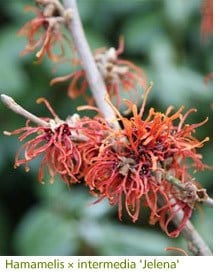 Witch hazels span two continents in the wild, Asia and North America. When plant hunters introduced Asian species into America in the early years of the 20th century they hybridised with their American cousins to produce larger flowered hybrids now known as H. x intermedia. Some named forms were deliberately bred by enthusiasts like the de Belder family who developed Kalmthout Arboretum in Belgium. They often chose family names and they include the widely grown 'Jelena' (a non-scented russet-brown from 1954) and 'Diane' (a slightly scented deep-red from 1969). Witch hazels span two continents in the wild, Asia and North America. When plant hunters introduced Asian species into America in the early years of the 20th century they hybridised with their American cousins to produce larger flowered hybrids now known as H. x intermedia. Some named forms were deliberately bred by enthusiasts like the de Belder family who developed Kalmthout Arboretum in Belgium. They often chose family names and they include the widely grown 'Jelena' (a non-scented russet-brown from 1954) and 'Diane' (a slightly scented deep-red from 1969).
Others appeared by themselves and these include the mysterious 'Pallida', which was first spotted on Battleston Hill at RHS Wisley in the 1940s and was probably a seedling. 'Pallida' remains the best pale-yellow witch hazel to look at and it also has an extraordinary scent, reminiscent of freesias. Many witch hazels are scented, although not all, but their fragrance varies from medicinal, to toilet cleaner, to floral. The yellows tend to have more scent and 'Arnold Promise' (a late variety developed at the Arnold Arboretum in America in 1963) has lots of small yellow flowers with a sweet, strong scent.

It's a popular misconception that witch hazels need acid-soil to thrive. They need good moisture-retentive soil, so won't thrive on chalk or thin soil. Other than that they do well on most. Like many plants with an Asian pedigree, or part pedigree, they need summer rainfall to emulate the rainy season. They also need good light to encourage next year's flower buds. They clearly signal their thirst in summer by turning their leaves to a vertical angle to slow down transpiration. This means they require water and lots of it. Gently tip two buckets over their roots and repeat this every time their foliage slants downwards.
Witch hazels vary in shape and size, although they are all slow-growing and shrubby rather than tree-like. For this reason pruning is limited to a tidy after flowering, only if needed. Remove any crossing branches or damaged wood and tip back the leaders a little to promote more flower bud, if you wish. Buy your witch hazels now, when in flower, but keep them somewhere sheltered and plant them outside once spring arrives. They also do well in containers.
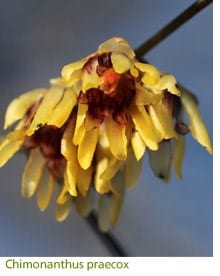 Generously Scented and Generously Proportioned Generously Scented and Generously Proportioned
The subtly-toned wintersweet (Chimonanthus praecox) is one of the most useful winter shrubs, producing almost translucent antique-yellow flowers warmed by a dash of blood-red. However this shrub needs a great deal of space and good light, taking up a 2m spread. Given both it will shine, although it has one bad habit. It's late to drop its foliage so if it's still clinging to a few last leaves pull them away gently so that the flowers, which look like ragged tutus on close inspection, can be seen to full advantage. This won't do any harm.
Being a Chinese shrub this needs summer moisture, so good soil is a necessity. Don't let size put you off either, for this twiggy winter shrub is one of the best for cut flowers. A few stems will scent a large room, but do try to give it a sheltered position because the gentle flowers can get damaged and browned by hard weather.
More Winter Flowers
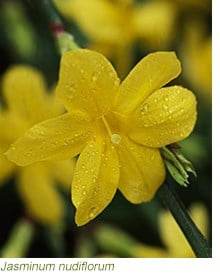 One of the brightest winter warmers is winter jasmine (Jasminum nudiflorum) and this versatile, hardy shrub can be tightly clipped against a wall, used to form an arch, or be allowed to flow over a low wall. It's easy and undemanding and the new olive-green wood makes a perfect foil for the bright-yellow starry flowers that open along the length of the stems, although sadly without any scent. If it's cut back after flowering and sited well, winter jasmine is one of the top winter performers and will provide fresh flowers from November until March. Pruning will promote new shiny stems, but if left alone (as many are) it will form a tangle of brown twigs with little flower. One of the brightest winter warmers is winter jasmine (Jasminum nudiflorum) and this versatile, hardy shrub can be tightly clipped against a wall, used to form an arch, or be allowed to flow over a low wall. It's easy and undemanding and the new olive-green wood makes a perfect foil for the bright-yellow starry flowers that open along the length of the stems, although sadly without any scent. If it's cut back after flowering and sited well, winter jasmine is one of the top winter performers and will provide fresh flowers from November until March. Pruning will promote new shiny stems, but if left alone (as many are) it will form a tangle of brown twigs with little flower.
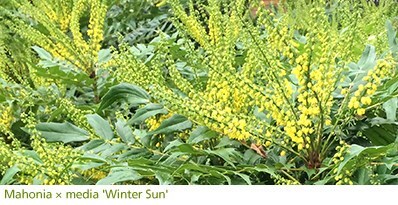
Mahonias also offer yellow flowers and forms of Mahonia x media have prickly evergreen foliage that's topped by fountains of scented yellow flower. 'Winter Sun' has bright-yellow upright racemes and 'Charity' is a softer yellow. The upright, architectural shrubs can flower as early as November and both will perform in shade whilst keeping their rigid shape.
A Long Flowering Season and a Hyacinth Scent
 Many early-flowering deciduous viburnum are scented, with pink mopheads of small flowers that appear in patches throughout winter whenever the weather allows. The most scented of all is a medium to large shrub that's ubiquitous to most gardens because it's easy and needs no special treatment to flower well. Viburnum x bodnantense 'Dawn' is highly fragrant on damp winter days whether it's growing as a hedge, or a specimen shrub. If winter delays the flowers it produces a full flourish in spring. Many early-flowering deciduous viburnum are scented, with pink mopheads of small flowers that appear in patches throughout winter whenever the weather allows. The most scented of all is a medium to large shrub that's ubiquitous to most gardens because it's easy and needs no special treatment to flower well. Viburnum x bodnantense 'Dawn' is highly fragrant on damp winter days whether it's growing as a hedge, or a specimen shrub. If winter delays the flowers it produces a full flourish in spring.
Daphnes - Capricious Creatures with Charisma
Daphnes need a tender touch and they are rarely, if ever, pruned. They also have an annoying habit of suddenly fading away in full glory, yet they are still worth growing, for the heady scent of their flowers are completely intoxicating. The earliest to flower is a Himalayan species,
D. bholua, found on high mountain slopes where monsoon rains make summers wet and cool. Various collections have been made in the wild, some deciduous and some semi-evergreen. The deciduous ones are high altitude specialists and very hardy. The semi-evergreens are low-altitude and less so. In their native habitat winters are intensely cold, so these daphnes flower in late-spring. However our warmer climate prompts much earlier flower here.
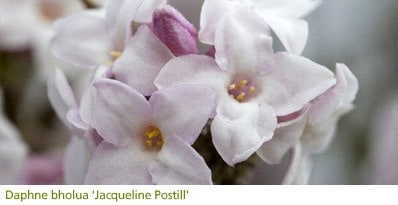 The most desirable form of D. bholua was not found in the wild however. It was a seedling raised from 'Gurkha' by Alan Postill of Hillier Nurseries. It stood out from all the others due to being completely evergreen so Alan Postill nurtured it and named it after his wife. 'Jacqueline Postill' has become a 'must-have' garden classic. It forms a columnar bush and flowers between January and March, depending on weather. It's easy, although it will die back in severe winters. Like all daphnes it has a lifespan of probably twenty years or so, but the combination of evergreen green leaf topped by mauve-pink flowers is completely unique and irresistible. The most desirable form of D. bholua was not found in the wild however. It was a seedling raised from 'Gurkha' by Alan Postill of Hillier Nurseries. It stood out from all the others due to being completely evergreen so Alan Postill nurtured it and named it after his wife. 'Jacqueline Postill' has become a 'must-have' garden classic. It forms a columnar bush and flowers between January and March, depending on weather. It's easy, although it will die back in severe winters. Like all daphnes it has a lifespan of probably twenty years or so, but the combination of evergreen green leaf topped by mauve-pink flowers is completely unique and irresistible.
Camellias

Most camellias need acid soil to do well. However the sasanquas, which flower between November and February, will tolerate good garden soil. They are found naturally in Southern Japan and have been grown in Japanese gardens for centuries as ornamentals and also for their oil. This is used in cooking, on the hair and for many other purposes. They are not highly frilly in form, like some camellias are. The Japanese admire sasanquas for their simplicity of form whether grown in temple gardens, or as miniature bonsai. Their ability to tolerate drought has made them highly popular plants throughout the world.
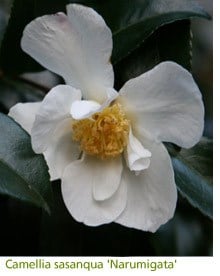 'Plantation Pink' is a robust variety, bearing lots of single pink flowers. 'Winter's Snowman' has white anemone-centred flowers, with a hint of clotted cream that prevents a glacial feel, and these look exquisite next to the glossy green foliage. The historic 'Narumigata' has cupped single white flowers softened by hints of pink. Single-flowered forms are less frost-affected. 'Plantation Pink' is a robust variety, bearing lots of single pink flowers. 'Winter's Snowman' has white anemone-centred flowers, with a hint of clotted cream that prevents a glacial feel, and these look exquisite next to the glossy green foliage. The historic 'Narumigata' has cupped single white flowers softened by hints of pink. Single-flowered forms are less frost-affected.
The sasanquas form large shrubs and are best planted in the garden, or in very large containers. Forms of C. japonica are best grown in ericaceous compost, in containers, because most garden soils are not acidic enough for them. Camellia flowers, especially the double frilly forms, brown if they thaw too quickly and for this reason camellias are best grown in areas that don't get morning sun. West-facing is usually the best aspect, although a sheltered north-facing position also works. 'Spring Festival', an early pink form with rose-like flowers, is grown all over the world. Or try the reliable red 'Adolphe Audusson' if you prefer stronger colours.
Finally make room for some double snowdrops, Galanthus nivalis 'Flore Pleno'. They may not be as elegant as the singles, but their frilly inner skirts ensure that they always look wide open - even on the dullest day.
|
Five Tips for January
 |
Prune apples & pears

Prune top fruit, ie. apples and pears, on clement days. However leave stone fruit, peaches apricots, plums and cherries until late-summer, when the flowing sap can seal the open wounds. This will help prevent the fungal disease silver leaf from getting into the tree via the cuts.
Winter pruning is all about shaping when it comes to the apple and pear, so take your time and always make sure you use good secateurs to make clean cuts. Felco no.2's are ideal for right-handed gardeners and they should outlast you. Felco no.9's are perfect for left handers. Cut away any crossing branches and remove any dead, diseased and dying wood. Then shorten the new growth on the leading branches, which will look shinier and darker. Aim to cut away the top third. Ideally you want to create an open shape with roughly six to eight limbs, although your tree will dictate how its pruned. Treat them all as individuals.
|
 |
Tidy and weed all areas where bulbs will flower this spring
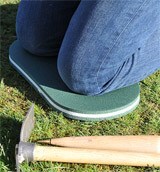
Last chance, because this really should have been tackled in the autumn. Try to avoid standing on the bed if you can. If not stand on a kneeler to spread your weight so that emerging bulbs are not damaged. Take out any weeds and collect any leaves as these tend to harbour slugs.
|
 |
Tidy up Evergreen Ferns
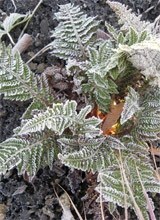
Wintergreen ferns may need attention. If the foliage has flopped, as it does on many Dryopteris, cut the fronds away to reveal the brown knuckles. Tidy up others and, if the ferns have open centres surrounded by a shuttlecock of fronds, clean out any trapped debris like fallen leaves. If left it can rot the middle of the ferns.
|
 |
Sort out Your Seed and Potato Order
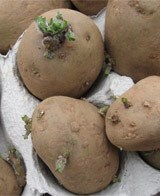
Make sure that the seeds and vegetables you'll need in spring are ordered in the lull before planting begins in earnest. The early potato 'Casablanca' is a new variety winning plaudits from vegetable growers. Look out for the seeds of parsnip 'Gladiator', a hybrid British-bred award-winning parsnip as well, but don't sow them until late-March and April. The shallot 'Golden Gourmet' and the onion 'Sturon' are both excellent varieties and both have all been awarded the AGM by the RHS. Buy now but plant in March.
Once your early potatoes arrive lay them out to chit, somewhere cool and light, on egg box trays. This will give them time to produce tight shoots from the eyes and hasten the crop. Maincrops do not need chitting and all potatoes can be planted in late-March or early April. Store shallots and onions somewhere cool and dry and, just before planting, trim the wispy tops off the bulbs.
Onions can be submerged, with just the tip showing, and planted 15 - 20 cm apart from March onwards. Shallots need more room to splay out and produce their cluster of bulbs. Choose a sunny position for shallots and plant them 22 cm apart in rows 22 cm apart. Leave the upper third of the bulb showing because shallots are more prone to rotting in damp soil.
Shallots grow better and ripen better in sunnier summers and, although they are not quite as hardy as onions, they often store for longer. There are red and yellow varieties of both and the yellow ones are the easiest to grow and they also store for longer. Water both in the early stages and try to plant them on fertile ground. Ideally your onion plot should have been manured or enriched in the months leading up to planting. On average an onion takes 20 weeks to mature and a shallot takes 26 weeks.
|
 |
Do some Winter Digging
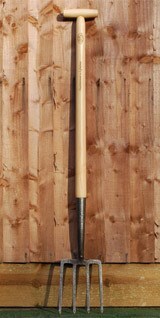
This sounds onerous, but all you have to do is turn over the soil with a fork and then let the weather break down the soil as it freezes and thaws. This is worth doing in all areas where vegetables will be planted because you will expose slug eggs and pests. The weather will break up the clods, but not strip out too many nutrients, and then the soil can be raked into a fine tilth in spring. Invest in a digging fork, if you don't have one and you're a chap. If you're a lady go for the De Wit Ladies Fork instead. Treat all tool handles with boiled linseed oil to preserve them and keep them smooth - while there's still time...
|
|


















